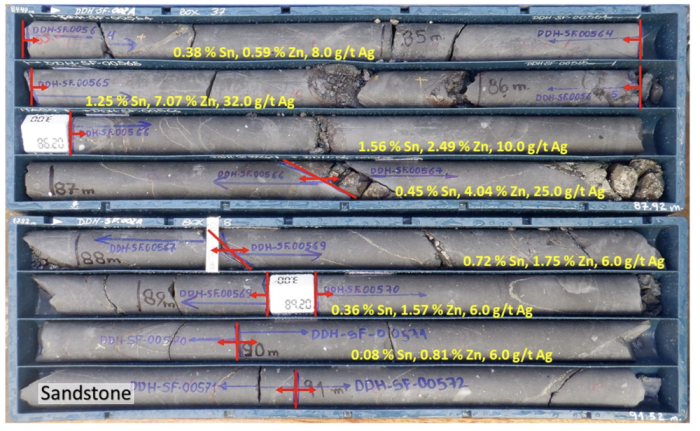Bolivia – Whitehorse Gold Corp. announced the assay results of its second confirmation drill hole (DDH-SF-002a) for the SF Tin Project, located in the Oruro Department, Bolivia. This is the second of the two confirmation drill holes to validate two historical holes reportedly drilled by Rio Tinto. The assay results of the first confirmation drill hole (DDH-SF-001) at the SF Tin Project were announced in the Company’s news release on October 31, 2022, which successfully verified the results from a nearby historical drill hole (ESF001).
Hole DDH-SF-002a was drilled at the same azimuth and dipping angle (azimuth of 90° and -60° dip) as the historical hole ESF002 but was collared 12 meters apart (Figure 1). DDH-SF-002a intersected 182.6 meters grading 0.20 % tin, 0.94 % zinc, and 24.0 g/t silver from 69.0 m to 251.6 m (Table 1), compared with 180.0 m grading 0.29 % tin, 1.06 % zinc and 13.3 g/t silver for the historical hole ESF002. The company is satisfied that hole DDH-SF-002a has confirmed the historical drill hole ESF002.
Gordon Neal, CEO & Director, commented, “This second confirmation drill hole validates hole ESF002 previously drilled by Rio Tinto. These results, in combination with the first confirmation drill hole, strengthen our commitment to complete the final acquisition of the SF Tin Project.”
Based on the option agreement (news release dated August 25, 2022), subject to satisfactory confirmation drill results, the company will proceed to acquire a 100-per-cent interest in the SF Tin project by paying a total of $3.65 million (U.S.) over two years.
Figure 1. Cross section (looking North), showing the historic hole ESF002 and the Company’s verification hole: DDH-SF-002a.

Mineralization intersected in hole DDH-SF-002a is hosted in fine to medium-grain sandstone of a blackish-gray color (greywacke) with clusters of multiple veins/veinlets (Figure 2) which contain pyrite, sphalerite, galena, cassiterite (SnO2), and trace amount of stannite (Cu2FeSnS4).
Figure 2. Polymetallic mineralization in core hole DDH-SF-002a, from 84.49 m to 91.52 m.

All SF core samples were collected by staff geologists and were shipped in securely sealed bags by Company staff in the Company’s vehicles directly from the field to AHK Bolivia Ltd., in Oruro, Bolivia, for preparation, and AHK Peru laboratory in Lima, Peru for geochemical analysis. AHK is an independent ISO/IEC 17025 and ISO 9001 accredited laboratory, and also UKAS ACCREDITED TESTING LABORATORY 1543, 1765, and 8738. All samples are first analyzed by a multi-element ICP package and FUS/ICP (peroxide fusion) for tin. Two types of certified reference materials, coarse blank samples, and duplicate samples, are inserted into normal drill core sample sequences prior to delivery to the laboratory for preparation and analysis. The overall ratio of quality control samples in sample sequences is a minimum of eight percent.
(Source: Press Releases – www.whitehorsegold.ca/news-releases/whitehorse-gold-intersects-182.6-meters-grading-0.2-tin-0.94-zinc-and-24-g-t-silver-at-the-sf-tin-project-bolivia/)
Please send your press releases to press@miningnewspaper.com or juan.lamadrid@miningnewspaper.com